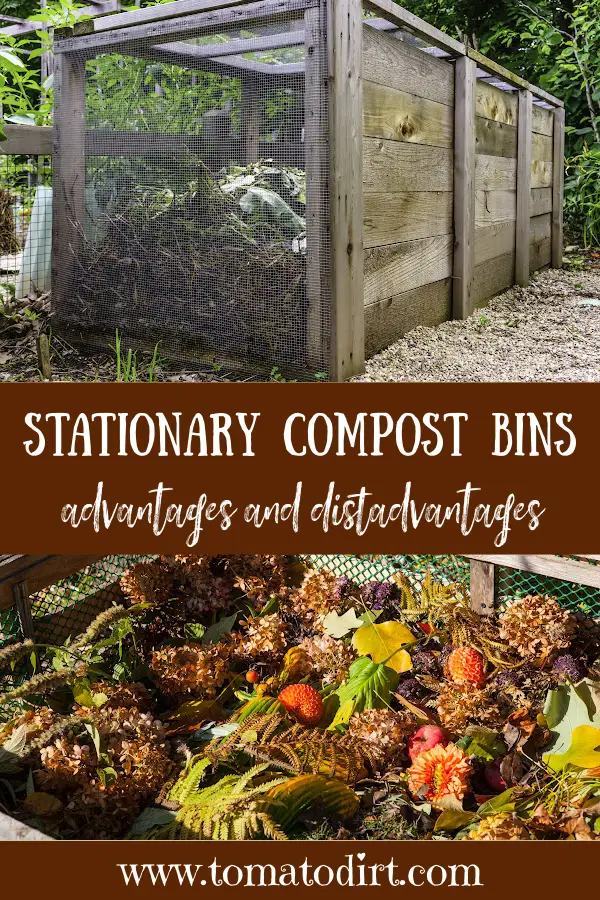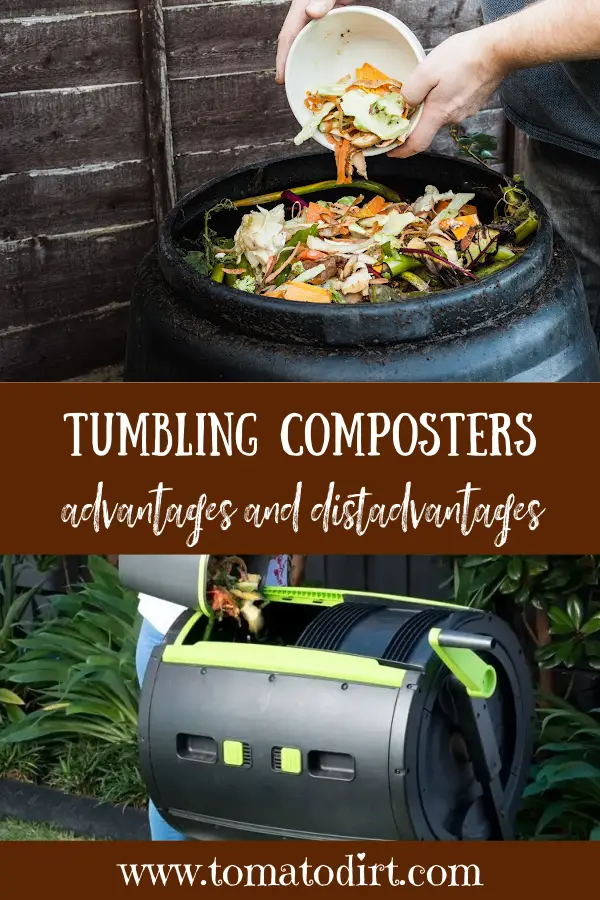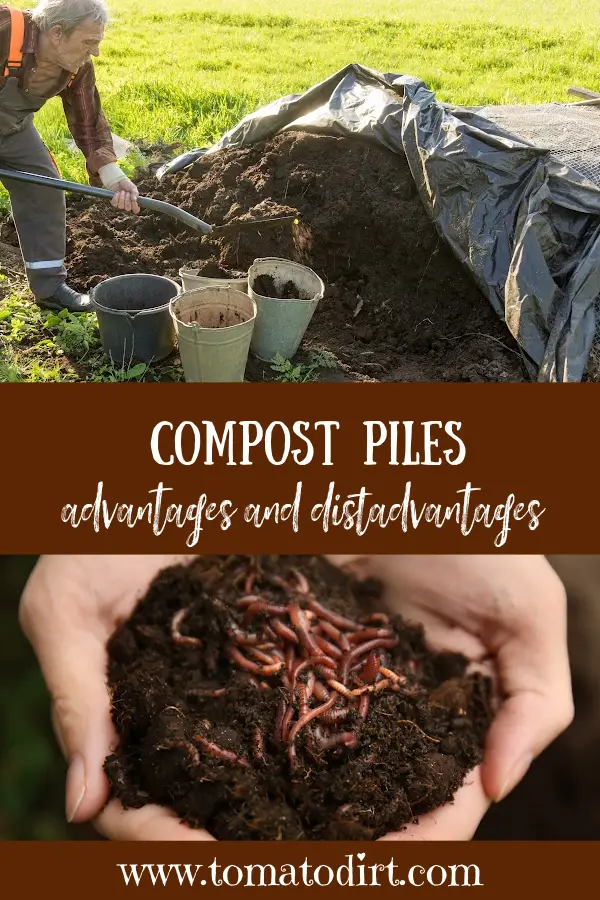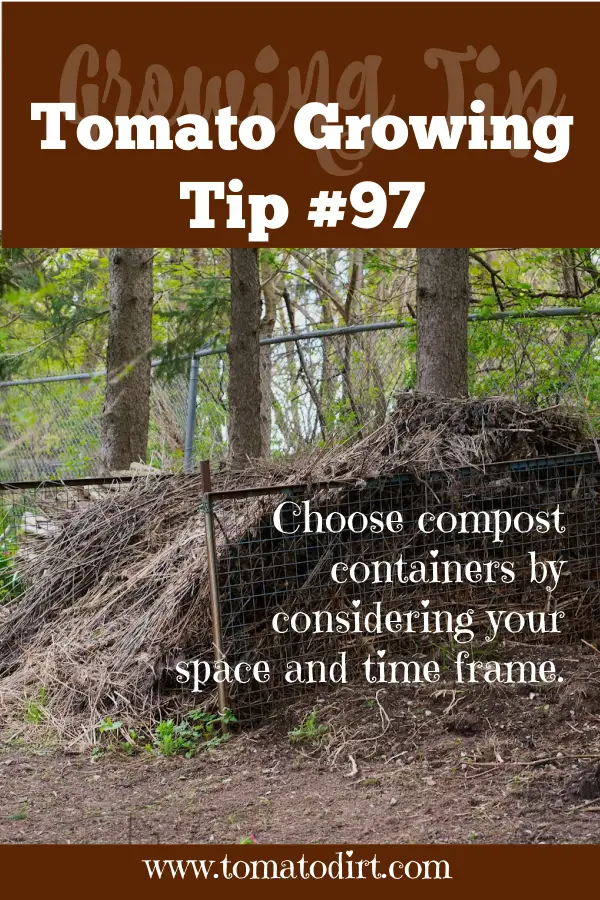FREE: 10 Must-Know Tomato Growing Tips Get The Guide
Read our affiliate disclosure here.
Compost Containers For Outside: Which Is Right for You?
Since 2010, Tomato Dirt has garnered 4.8+ million views, making it the web’s leading online source for growing tomatoes in the home garden. Award-winning writer and Tomato Dirt owner Kathy Widenhouse has helped thousands of home gardeners grow healthier tomatoes. Be one of them when you get Tomato Dirt’s Growing Guide here.
Posted 9.16.24
Compost is decomposed organic material that becomes a nutrient-rich soil amendment. If you have compost containers for outside, you can make plenty of your own “black gold” to add to your garden soil for better crops.
Some gardeners cannot compost outdoors because they live in an apartment or have limited outdoor space. If that’s you, try vermicomposting (using worm bins to break down organic materials and food scraps into compost) or a kitchen compost bin (for odor-free composting that takes minimal space.)
But if you have even just a little bit of space, you can choose compost containers for outside that fit your budget and your situation.
Here’s the dirt on the 3 main types of composting containers. And at the end, we compare the three types to help you choose.
3 main types of compost containers for outside
1. Stationary compost bins
A stationary compost bin is a type of composting container that remains fixed in one location, unlike tumblers or rotating composters, which are designed for regular turning. Bins are used for passive composting, where organic materials like kitchen scraps, garden waste, and leaves are layered and left to decompose over time with minimal intervention.
What is a stationary compost bin made of?
Stationary compost bins can be made from various materials such as plastic, wood, metal, or a combination of these materials. You can make your own stationary compost bin or purchase a kit. You can choose an open bin, without a cover, to allow rain to naturally moisten the compost and to provide plenty of airflow. A closed bin has a covering to keep out pests.
- Plastic is a popular material for stationary compost bins because it’s durable, affordable, and moisture resistant.
- Wood compost bins are made of cedar or other rot-resistant woods, which look natural but also provide good ventilation for the compost. Your bin can be completely wood or have wooden posts with metal sides.
- Metal compost bins are typically made of galvanized steel or aluminum to last a long time and keep rodents away. Some gardeners use flexible wire or mesh for the sides of their stationary compost bins to keep them lightweight and breathable.
How does composting in bins work?
- Layer materials. Organic matter, such as fruit and vegetable scraps, grass clippings, and dry leaves, are added in layers to the bin.
- Let the materials decompose. The bin’s contents break down naturally over time, aided by microorganisms, worms, and insects. Heat from the decomposing materials and good airflow helps the process.
- Turn occasionally. Unlike tumblers, stationary bins don’t require turning each week – although you want to do so every month or two to help with air flow. And don’t forget to moisten the materials in your compost bin if it’s closed or if you’ve been in a drought.
What are the advantages of stationary compost bins?
- Capacity. Bins can handle a large amount of organic waste at once.
- Cost savings. Compost bins can range from small to large, single bin to dual bin – but they are more affordable than complex composting systems.
- Low maintenance. A stationary compost bin requires less effort compared to rotating composters, as turning the compost is only occasional or even optional.
- Stability. Bins stay in one place, making them convenient for ongoing composting without moving parts. Plus, a bin helps contain the composting materials in a designated area.
- Airflow. Well-designed compost bins include ventilation holes or slats, which promotes airflow and aids decomposition.
What are the disadvantages of stationary compost bins?
- Time frame. Without regular turning, decomposition can take longer compared to tumblers.
- Pests. If not managed properly, open stationary bins can attract pests like rodents or insects.
Stationary compost bins are ideal for gardeners who want a simple, low-maintenance composting solution with the ability to handle a large volume of waste over time.
2. Tumbler composters
A tumbler composter is a type of composting bin designed to be rotated or “tumbled” to mix the organic materials inside, speeding up the decomposition process. These composters are typically barrel-shaped and mounted on a stand or axis that allows easy spinning. The tumbling action aerates the compost, giving it more oxygen so organic matter breaks down faster. Plus, aerobic decomposition is less smelly than anaerobic decomposition in a compost bin or compost pile.
What are the key features of tumbler composters?
- A rotating mechanism. By turning the barrel, you help the compost materials be well aerated.
- An enclosed design. Most tumbler composters are fully enclosed, which helps to retain heat and moisture while keeping pests out.
- Ventilation. All those luscious microbes need oxygen in order to help organic material to decompose. Tumblers have aeration holes to allow air to move about its contents.
- Chambers. Some models have two chambers, allowing you to add new compost materials in one chamber while the other chamber "cooks" (decomposes).
How do tumbler composters work?
- Load. You add a mix of green (nitrogen-rich) materials like food scraps and brown (carbon-rich) materials like dry leaves or paper.
- Tumble. Turn the bin regularly to mix the materials, ensuring that oxygen reaches all parts of the compost. Most gardeners recommend “tumbling” the bin 2-3 times a week.
- Decompose. The compost heats up and breaks down quickly, often producing finished compost in a few weeks to a couple of months, depending on the material mix and environmental conditions.
What are the advantages of tumble composters?
- Speed. The regular tumbling provides more aeration, which accelerates the composting process. Finished compost is available in less time.
- Pest protection. The enclosed design helps keep pests like rodents, raccoons, and flies away, unlike open compost piles or bins.
- Ease. Tumblers are easy to turn, and many have ergonomic handles or designs requiring minimal effort when mixing the compost. Unlike stationary bins or piles that require manual turning with a pitchfork or shovel, tumblers make mixing the compost quick and convenient.
What are the disadvantages of tumbler composters?
- Smaller capacity. Tumblers take up less space than compost bins and compost piles. That means they have less room for organic material, which in turn means they produce smaller amounts of compost. For some, that may be an advantage – if you have little kitchen and yard waste, for instance. But a tumbler is less suitable for people who generate a large volume of compostable waste.
- Cost. Tumbler composters tend to be more expensive than stationary bins because of their mechanical design. On the flip side, they are long-lasting.
- Weight. Some larger models can be difficult to tumble when they are full of material, especially for people with limited strength.
- Moisture management. Because tumblers are enclosed, excess moisture can accumulate inside. You’ll need to be careful to monitor moisture in your composting materials, add dry matter if needed, and avoid letting excess water get in the tumbler. Soggy compost doesn’t decompose.
When should I use a compost tumbler?
- For quick composting. If you want compost quickly and are willing to turn it regularly, a tumbler is a great option.
- For pest control. Tumblers are ideal for those who want to avoid pests.
- When you have limited space. If you have a small yard or live in an urban area, the compact and enclosed design of a tumbler can be more convenient than an open pile.
Tumble composters offer a convenient and efficient way to compost for those seeking quicker results and pest-free composting. However, their smaller capacity and higher cost are trade-offs.
3. Compost pile
Okay, it’s technically not a “compost container.” A compost pile is an outdoor heap of organic materials like food scraps, grass clippings, leaves, and other biodegradable waste that is left to decompose naturally over time.
Unlike compost bins or tumblers, a compost pile is open to the elements. Some gardeners may use simple enclosures made of wire or wood to keep the pile contained. But like compost bins and tumbler composters, a compost piles relies on microorganisms, heat, oxygen, and moisture to break down the materials into nutrient-rich compost that can be used in gardens and landscapes.
What are the key features of a compost pile?
- Open structure. A compost pile is usually built directly on the ground and is not enclosed as is a bin or tumbler.
- Layering. Materials are added in layers, alternating between "green" (nitrogen-rich) and "brown" (carbon-rich) materials to maintain balance.
- Decomposition. Over time, the materials break down through the natural action of microorganisms, heat, and oxygen.
How does a compost pile work?
- Layer organic materials. Alternate layers of green materials (fruit and vegetable scraps, grass clippings, coffee grounds, and fresh plant matter) and brown materials (dried leaves, straw, cardboard, paper, and wood chips) to create the right balance of nitrogen and carbon.
- Let materials decompose. Microorganisms like bacteria and fungi, along with insects and worms, break down the organic matter. The pile heats up due to microbial activity, speeding up decomposition.
- Turn the pile. To accelerate the process, the compost pile can be turned or aerated periodically with a pitchfork or shovel to introduce oxygen, which helps the microorganisms work more efficiently. My husband uses his tractor a couple of times a year to turn layers of the open compost pile. Or you can simply let your compost pile decompose on its own. The organic material will take more time to break down to usable compost, but you’ll save effort.
- Use the finished compost. After a few months to a year (depending on conditions), the materials will break down into dark, crumbly compost, which is nutrient-rich and can be added to gardens or used as mulch.
What are the advantages of a compost pile?
- Capacity. Compost piles can be as large or small as needed, making them ideal for gardeners who generate a lot of organic waste.
- Cost savings. Since a compost doesn’t require special materials or special equipment (other than a pitchfork and elbow grease), a compost pile is a low-cost way to acquire black gold.
- Flexibility. You can add large quantities of organic material at once, and the process is more forgiving in terms of what can be composted.
- Convenience. To add content, you just throw your kitchen scraps and dump your raked leaves on the pile. Most of the time, Mother Nature handles the moisture when it rains.
What are the disadvantages of a compost pile?
- Speed. Because there is less aeration compared to tumblers or enclosed bins, compost piles may take longer to break down – often several months to over a year. Turning the pile every few weeks helps introduce oxygen, which speeds up decomposition.
- Pests. Open piles can attract pests like rodents, raccoons, and flies if food scraps are not buried properly. When adding food scraps, cover them with a layer of brown materials like leaves or straw to discourage pests and minimize odors.
- Odor and appearance. A compost pile can produce unpleasant smells if not managed properly, and some people may find an open compost pile unsightly. But if you have space or a barrier (like a tree or fence), you can hide your compost heap. And proper turning ensures aeration which in turn prevents nasty smells. Ensure the pile stays moist, like a wrung-out sponge, but not soggy. Keep a good balance of green and brown materials to prevent the pile from becoming too wet (leading to odors) or too dry (slow decomposition).
A compost pile is a simple and effective way to turn organic waste into nutrient-rich compost, making it a valuable tool for gardeners. While it may take longer to decompose compared to other composting methods, it is flexible, cost-effective, and can handle large quantities of material.
Compost bin vs compost pile vs tumbler
Here we compare the 3 types of compost containers for outside against a gardener’s priorities and show you which option comes out ahead.
- Appearance
This one’s a toss-up between a tumbler composter (if you have it situated well) and a compost bin (if it’s kept neat). - Convenience
All 3 offer conveniences. A compost pile and a compost bin make it easy to add organic material – pretty much anytime you’ve got some. A tumbler requires you to keep track of what you drop in the bucket and when. Meanwhile, a rotating drum compost tumbler is convenient because it’s easy to turn, while the other two require a bit of muscle.
- Capacity
Winner: compost pile – if you’ve got the space. You can heap on as much organic material as you’d like. A close second are compost bins. - Cost
Top choice: compost pile, hands down. It costs nothing. You find a spot on your property, begin layering, moisten, and turn. But you can also build a DIY compost bin for very little – just a few boards and some chicken wire. - Pests
Tumbler composters win the day. Tumblers are completely enclosed, leaving critters to fend for their meals elsewhere. Worst? Compost piles. They’re exposed. And compost bins are not far behind if they’re open to the elements. - Space
A compost tumbler takes the least amount of space. Sure, there are large ones. But tumblers are portable. You can even move one into your garage if you’ve having a backdoor barbeque. Compost bins and compost heaps need more square footage. - Time frame
Compost tumblers are quickest, thanks to regular turning, better pest resistance, and easier to manage in terms of mixing materials.
What type of container is best for composting outdoors?
That depends on how much space do you have in your garden … how many kitchen scraps and amounts of organic material you want to recycle … and how much sweat you want to invest.
But no matter which compost containers for outside you choose, you can’t go wrong by saving organic waste from the landfill and making it into black gold for your garden.
More on making compost for tomatoes
4 Types of Compost Bins: Which Is Best for You?
How to Compost Tomato Plants ...
How to use a kitchen compost bin to make black gold ...
2 types of composting for the home gardener ...
When to compost: a guide to composting through 4 seasons...
More composting tips on our Pinterest board ...
Return from Compost Containers for Outside to Tomato Dirt home
As an Amazon Associate and Rakuten Advertising affiliate I earn from qualifying purchases.
SHARE THIS PAGE:
FREE! 10 Must-Know Tomato Growing Tips: 20-page guide
Get yours here:







